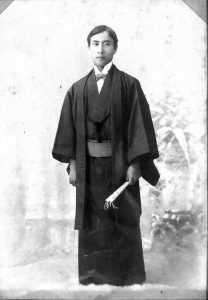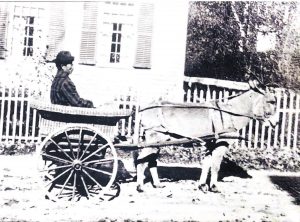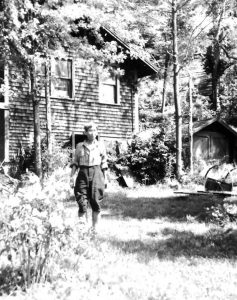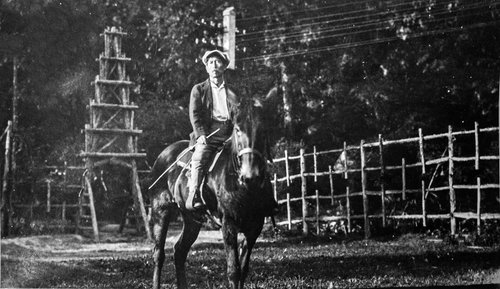By Emma Wiley
While many know Gillette Castle and its dramatic owner—famous actor William Gillette—the estate also contains a piece of Japanese history. For over four decades, Japanese-born Yukitaka Osaki worked for Gillette, becoming a recognizable neighbor in the Hadlyme community.
Osaki lived in Connecticut during a period of increasingly tense foreign relations between the United States and Japan—ultimately escalating to war. When Osaki moved to Hadlyme, there were very few Japanese or other Asian people living in any of the surrounding towns. Osaki’s story is a unique immigrant experience in a small Connecticut town during the early 20th century.
Osaki’s Journey from Japan

Young Osaki – Connecticut Department of Energy and Environmental Protection from the archives at Gillette Castle State Park
Yukitaka Osaki was born in the Kanagawa Prefecture of Japan in 1865, the middle son of three boys in his family. After growing up in Japan, in his 20s, Osaki and his older brother, Ozaki Yukio, arrived in the United States in 1888. Yukio eventually returned to Japan, but Osaki remained in the United States. A few years later, Osaki attended Oberlin Academy—preparatory school for Oberlin College—during the academic year 1894-1895, but he did not graduate.
While Osaki lived in the United States for the rest of his life, Yukio became a well-known politician in Japan, who considers him their “God of constitutional politics.” During his tenure as mayor of Tokyo, Yukio facilitated Japan’s 1912 gift of the famous cherry trees that now surround the Tidal Basin in Washington, D.C. Despite Japan and the United States’ increasingly hostile relationship during the early 20th century—including the Immigration Act of 1924 which barred Japanese immigration to the United States—the brothers made time to see one another during Yukio’s subsequent visits.
Osaki and William Gillette

Osaki with his donkey in town – Connecticut Department of Energy and Environmental Protection from the archives at Gillette Castle State Park
Around 1896 to 1897, shortly after his time at Oberlin Academy, Osaki met William Gillette—a famous actor best known for his iconic portrayal of Sherlock Holmes. Gillette hired Osaki to work on his houseboat The Holy Terror and, a few years later, his newly commissioned boat, Aunt Polly. Osaki eventually became Gillette’s valet, assistant, and stage dresser for his performances.
In 1919, Gillette moved into his newly built castle—the Seventh Sister Estate or “Gillette Castle”—on the border between Lyme and East Haddam. He provided Osaki with his own small house on the southern corner of the property, close to the river and the village of Hadlyme. Osaki lived there for the rest of his life with his mule, donkey, and renowned gardens. He was a common sight in town, picking up mail and running other errands for himself and Gillette. By all accounts, over the four decades that Osaki worked for Gillette, the two men became close friends.
WWII and the End of Osaki’s Life
When he died in 1937, Gillette provided for Osaki in his will—leaving him the use of his small house and gardens for the rest of Osaki’s life. Having retired from most of his duties years before, Osaki remained in Hadlyme for the remainder of his life.

Osaki in his garden – Connecticut Department of Energy and Environmental Protection from the archives at Gillette Castle State Park
Japan’s involvement in WWII, particularly the attack on Pearl Harbor, had a profound effect on Osaki. In a letter to Elizabeth Ives Gillette (William Gillette’s niece) in April 1942, Osaki wrote that he was “amazed, astounded, dumbfounded, – shocked and stunned beyond my power of expression” at the attack on Pearl Harbor and “can see nothing but the total destruction of Japan in a year or so.” During WWII, the US government incarcerated approximately 120,000 Japanese and Japanese Americans—mostly from the West Coast. Despite reports of visits by officials, the FBI never incarcerated Osaki for his Japanese citizenry.
Yukitaka Osaki died on September 29, 1942, after months of declining physical and mental health. His neighbors and friends, the Hamilton sisters, hosted his funeral service at their home and Osaki was buried in Cove Cemetery in Hadlyme.
Today, Osaki’s house is part of Gillette Castle State Park, but it is not currently open to the public. Since Osaki was a significant part of Gillette’s life for four decades, the museum has included his story in the interpretation of the castle. In addition, the East Haddam Stage Company has brought Osaki’s story to life with a one-person drama, Osaki-san, William Gillette’s Gentleman Valet. The life history, photographs, and stories of Yukitaka Osaki continue as evidence of one of the first Japanese immigrants in Hadlyme, Connecticut.
Author’s note: Japanese naming conventions dictate that the family name comes before the individual’s given name, ex. OZAKI Yukio. While living in the United States, however, Yukitaka Osaki chose to go by the western name order convention. The author would also like to thank Paul Schiller, David Holahan, and the Friends of Gillette Castle State Park for their help and resources.
Emma Wiley is the Digital Humanities Assistant at CT Humanities and holds a B.A. in History from Vassar College.









